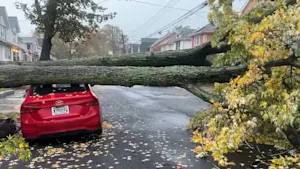Lab tests reveal dangerous levels of lead falling from several MTA structures
After sending samples to a lab, the results showed lead levels up to 12 times higher than standards from the Centers of Disease Control and Prevention.
Share:
More Stories
1:24

47 customers without power in Wakefield due to fallen tree
17m ago1:48

Major flooding impacts residents on Westchester Avenue
21m ago2:09

Food pantry lines last hours as cuts to SNAP benefits sink in
3h ago1:40

Bronx residents without running water after Van Nest water main break
4h ago
New York City Storm Photos & Videos
4h ago2:28

Bronx man accused of killing cat in ‘ritualistic act’ arrested after community tips, advocates say
4h ago1:24

47 customers without power in Wakefield due to fallen tree
17m ago1:48

Major flooding impacts residents on Westchester Avenue
21m ago2:09

Food pantry lines last hours as cuts to SNAP benefits sink in
3h ago1:40

Bronx residents without running water after Van Nest water main break
4h ago
New York City Storm Photos & Videos
4h ago2:28

Bronx man accused of killing cat in ‘ritualistic act’ arrested after community tips, advocates say
4h agoResidents and elected officials are demanding answers after lab tests revealed that dangerous levels of lead are falling from several Metropolitan Transit Authority structures.
Salvatore Polizzi runs his family’s restaurant just steps away from the Knickerbocker Avenue subway station. In 2020, he noticed pieces of dried paint falling from the elevated M line structure, and decided to collect samples under and around Knickerbocker Avenue, Myrtle-Broadway, and Myrtle-Wyckoff stations.
After sending those samples to a lab, the results showed lead levels up to 12 times higher than standards from the Centers for Disease Control and Prevention.
“I was shocked, first and foremost, you don’t necessarily expect that,” said Polizzi. “Why wasn’t this caught? Where are the agencies that are supposed to be overseeing this?”
On Tuesday Polizzi, elected officials and concerned neighbors from Community Board 4 rallied under the MTA structure to demand action.
“Bushwick deserves to have investments in our public infrastructure,” said Council Member Sandy Nurse. “We deserve to have a safe community where we can walk without being exposed to high levels of toxic materials.”
Work on the M line started in Queens and was slated to make its way to Brooklyn by 2021. In 2021 at a public hearing, the MTA announced the fixes would be coming in the summer of 2022 – but they haven’t happened yet.
“That stuff can be touched, it can be picked up, it can be picked up by children, they can put their hands in their mouths or near your face, on the skin,” said Nurse.
In a statement, the MTA said the following:
“The safety of customers and communities served by the MTA is a top priority. This commitment is reflected in the MTA’s current capital program that includes 26.5 miles of elevated structural repairs and painting, more than six times the amount in the prior plan. The structural maintenance program follows appropriate safety protocols that will not be compromised.”
But the MTA must first hire someone to complete the job before work on the Brooklyn portion of the M line can begin, which means residents will have to wait.
“It makes you think that perhaps the MTA is not taking this seriously enough,” said Polizzi.
More from News 12
1:48

Major flooding impacts residents on Westchester Avenue
2:58

STORM WATCH: Heavy rain and gusty winds Thursday evening for The Bronx
1:24

47 customers without power in Wakefield due to fallen tree

New York City Storm Photos & Videos
0:26

Optimum offering free calls, texts from the US to Jamaica due to Hurricane Melissa
2:28
